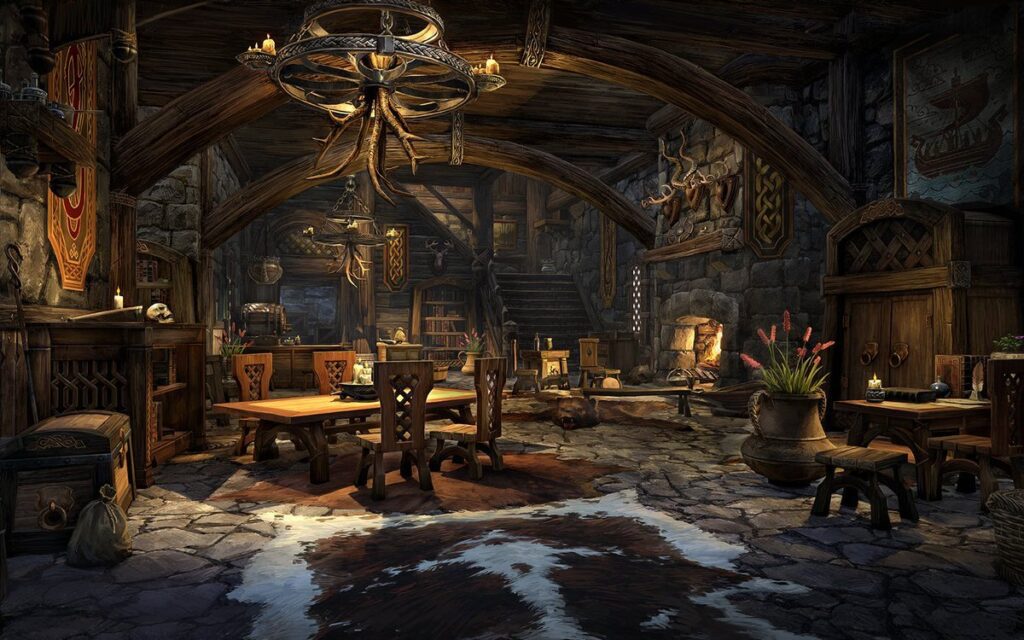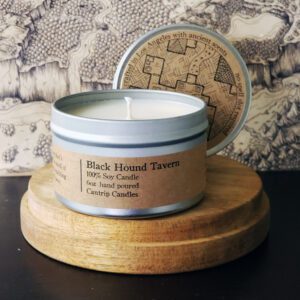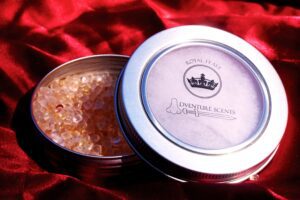The sounds of a busy waterfront marketplace, the smell of a crackling campfire, and the dim lights of a crowded tavern are all things dungeon masters have described time and time again. Explaining things like this is a great way to set the scene for your players and make them feel like they’re there. But is there anything you can do to take your ambiance to the next level? There most certainly is and I’ve got some tips to help you do it.
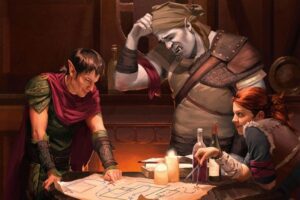
Table of Contents
What is Ambiance?
The ambiance is the environment around you and being able to convey the proper ambiance of a scene can help keep your players engaged and feel like they’re fully immersed in the world you have set up for them. This helps set the tone for the events that are taking place and can influence how your characters decide to roleplay as things unfold. You want your players to feel like they’ve been transported to a faraway place and are experiencing the encounter as if they’re there and the best way to do that is to focus on all of their senses.
Focus on your senses
My first bit of advice for trying to create a better ambiance is to make sure you mention all four senses when you are describing a scene; sight, sound, smell, and touch. You don’t have to go into excruciating detail but making a quick mention of something that describes each of the senses can make a huge difference.
Let’s go back to the example of the waterfront marketplace. You can tell your players that they’ve entered a busy waterfront marketplace and they’ll probably be able to put together what that looks like. Or you could give them something like this:
“As your party enters the marketplace, the smell of fresh fish is in the air as you see busy rows of people moving through aisles of stalls with vendors shouting at passersby trying to sell the day’s catch. As you push through the crowds you can feel the cool breeze from the ocean carrying the scent of salt.”
You can keep it simple with a quick 2-3 sentences, just make sure to hit each of the four senses. This can make a big difference in how your players react to a scene and the more invested you can get them in what’s happening they’ll be more engaged and the more memorable of an experience it will be.
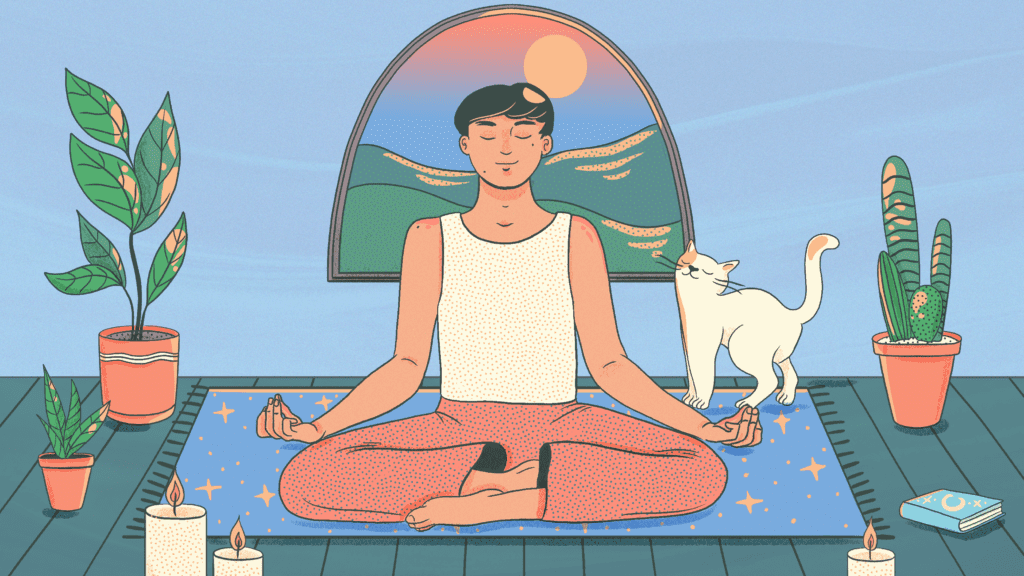
Elevate Those Senses
Honing your descriptions in on the proper senses will elevate your game, but for those DMs that want to provide an ambiance that no one will forget these following tips will be for you. The tips and tools I’ll mention will still focus on the senses of sight, sound, touch, and smell but will help you bring those senses to life and make your players feel like they’re living the scenes their characters are experiencing. I’ll even address ways for DMs to incorporate these techniques into their online games.
Play Background Noises or Soundtracks
Let’s start with the one that’s easy for most people to do, playing background noise or soundtracks. Playing a song when you say there is a bard playing in the tavern can help bring the scene to life or you can even play a soundscape meant to feel like you are walking through a windy forest. There are a lot of different resources out there for finding sounds and songs for any situation you could think a D&D game would need. Before I get into some of the different tools and where to find them, I have some tips for picking out your soundtracks and background noise.
Use Music Without Vocals
When you are searching for songs to use during a game session make sure you use music that doesn’t have any vocal parts. Songs with vocals can be distracting during a game, especially if it is a song that people already know or if you are going to use it more than once. People may be tempted to sing along and tend to have a harder time paying attention to the game.
Keep Background Noise in the Background
I’m a big fan of using different kinds of soundscapes to get as much immersion as possible from every scene. Just make sure to balance your volume with the volume of the room. These soundscapes should fade into the background but remind your players at every moment exactly what scene they are in. It shouldn’t be loud enough to be distracting or anyone should have to try to speak over it.
Create Playlists Ahead of Time
When prepping for your session think about what kind of noises your characters might experience during your game. A lot of resources like YouTube and Spotify will let you build playlists of content. Try to set aside some time to put together a playlist of soundscapes and/or music that you could potentially use throughout your session.
Use Sound Effects/Soundboards
Playing that perfect sound effect for when a player casts a fireball to win the fight or the death cry of a slain enemy can build excitement at the table. There are plenty of soundboards you can find online with a collection of sounds and even apps that will allow you to create your own soundboards by uploading whichever sounds you would like. If you do decide to use sound effects, try not to overdo them and save them for important moments like when a player delivers a killing blow or to accentuate a dramatic point in the story.
Resources
There are a lot of resources out there to help you with elevating the sounds of your D&D game, both for free and some that are paid services. Below are some great options for each.
Free
YouTube, Spotify, Reddit, TurboBard, Tabletop Audio
Freemium
Free Sounds, SoundSnap, Syrinscape
Elevate Your Sounds for Online Play
The easiest way to implement any of these tips or resources for online play is by using the Zoom application. You can use whichever resource you would like for your sounds while on your computer and with Zoom’s ‘Share Computer Audio’ feature you can share them all with your players. Also, it isn’t as easy to pull off for in-person games but running a game from your computer offers you the opportunity to take your audio experience to the next level by using a voice modulator for your monsters and NPCs. By using an application like VoiceMod you can seamlessly transition between different voices for your wide range of characters.

Give Your Players Something They Can Feel
This does take a bit of planning in advance but using things like set props, reference pictures, and other physical handouts in your game that your players can feel can help elevate your games in multiple ways. Let’s take a look at each one.
Set Props
Doing a little bit of set dressing can help step up your ambiance. For instance, if you know your players will be visiting a tavern during the session, something as small as having candles set out on your table can help them feel like they are there. You can go the extra mile and have wine bottles with old-timey labels on them out as well or you can even set tankards in front of them once they enter the tavern. Maybe they will find themselves in a bountiful forest. You can get fake garlands or vines to wrap around the edge of your table or by putting out other kinds of plants in the room or on the table. Small things like this can help your players feel fully immersed due to their surroundings in real life matching those their character is experiencing.
Reference Pictures
This one is pretty simple if you have a printer and if you don’t you can always visit your local library. When you are describing an important NPC, location, item, or whatever, having a picture to hand to your players can help with two things; it can help keep your players engaged and paying attention, and it can help ensure they can see exactly what you are wanting them to see while cutting down on the effort you have to put into your descriptions. Having a picture you can put into their hands also gives each player the chance to take the time they would like to study it, you can give them a folder to collect the pictures in and keep on hand should they wish to recall them later.
Physical Handouts
Making physical handouts for your games can take a good amount of effort, but the payoff is normally pretty great. The look on your players’ faces when they break the wax seal on a scroll you’ve given them containing a campaign-changing message from an NPC makes it so worth the effort. You don’t have to do things like this for every single session but every once in a while going the extra step for an important moment in the story can make it that much more memorable for both of you.
Handouts Online
You just won’t be able to capture the same feeling of handing someone a prop during an online game session. However, you can still share pictures with your players during online games so do that as much as possible. Roll 20 and other VTT systems will have functions that allow you to share images and/or documents with your players that then give them access to it later. You can use this to show pictures of NPCs, letters & documents, and pictures of items or locations they come across. The more you do this the closer you can get to the excitement of handing something like a prop to your players.
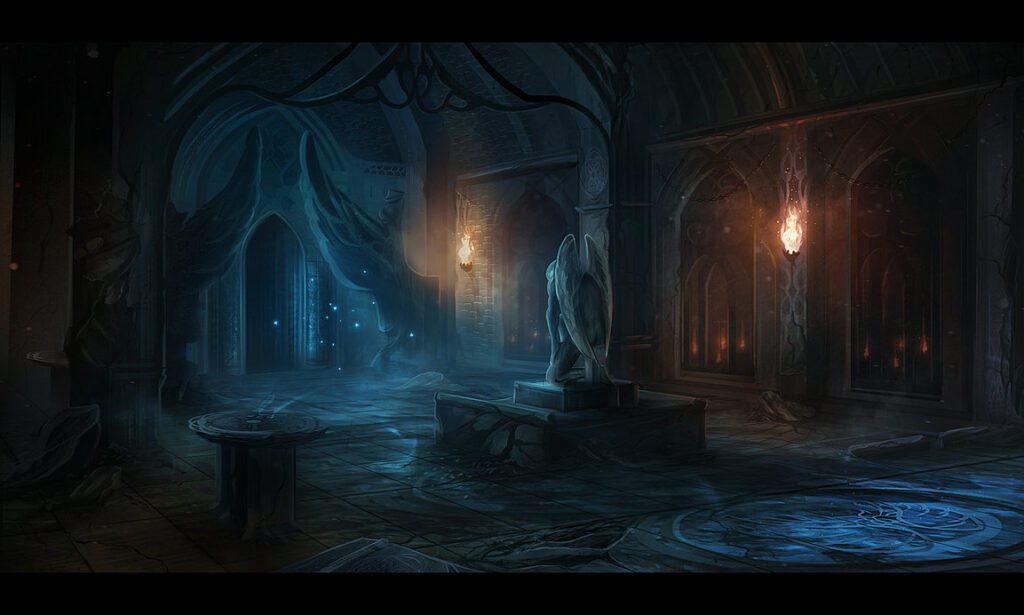
Use Mood Lighting
This one might sound easy enough, but through some experiments of my own have found that messing with lighting during a game can be more than a bit tricky. You need to experiment with your space and get to know it. These are the tips that I have come up with.
Candles
I know that running a session by candlelight sounds like a great way to add some ambiance to your game but it can prove to be more difficult than you think. When you are trying to light a whole room with just candles it may not be difficult to capture the ambiance you want with some darkness and flickering shadows but it can become troublesome for trying to play a game. If it is too dark it can be difficult for people to see their character sheets and read books. It helps to have a soft light to help out the candles so people can see. You can even soften the light a bit more by putting a thin cloth over it, just make sure it doesn’t touch the light bulb directly. Again, you don’t want your lighting to become distracting enough to take away from the game.
Colored Lighting
Changing the color of the lighting in your space can severely change the tone in the room and can be achieved relatively easily. These days color-changing LED lights and light strips are very easy to find and quite affordable as are colored light bulbs. Here are a few items that are affordable options for bringing mood lighting into your games.
Vanance Smart Light Bulbs
These color-changing light bulbs come with a remote or can be connected to your phone via Bluetooth or wi-fi, works with Alexa Google Assistant, and can even sync with your music. They can cycle through a wide range of colors and can be purchased in singles or a 4-pack.
Melpo LED Flood Light
With similar functions to the color-changing smart light bulbs, these are a floodlight style of light so they get much brighter which is good for outdoor use and boasts having over 16 million colors. They can also be controlled via an app and are sold in pairs, but doesn’t function with Alexa or other voice assistants.
Tenmiro LED Strip Lights
Just like the other options mentioned, these LED light strips come with a remote or can be controlled with an app on your smartphone. Strip lights make it easy to add color-changing lighting to any room with an adhesive back that allows you to stick it to most surfaces. Strip lights like these are very affordable and can be purchased in a variety of different lengths.
High-quality lighting has become rather inexpensive these days and can give quite a boost to the ambiance in your game room. Even then, if you are looking for an even more inexpensive way to go, you can always drape some thin, colored cloth over some lamps to get the same effect. Just make sure you can do so without resting the cloth on the light bulb!
Mood Lighting Online
You can’t control the lighting in someone else’s room. But Roll 20 and other VTTs can offer lighting options you can’t get in an in-person game thanks to their Dynamic Lighting tool. With this, you can set up lights, walls, and doors on any map you want to use in Roll 20 so that your players can only see the parts of the map that their characters can see. This is very difficult to achieve when working with physical maps and miniatures. With this tool, you can also set up individual character tokens with darkvision if their characters have it and when there is no light on the map, those characters will still be able to see. You can even adjust the color on their darkvision so that they can only see the map in shades of gray, just like how their characters would see it. You may not be able to mess with their lights, but there are tools for online play that you can use to let what your players see add to your overall ambiance.
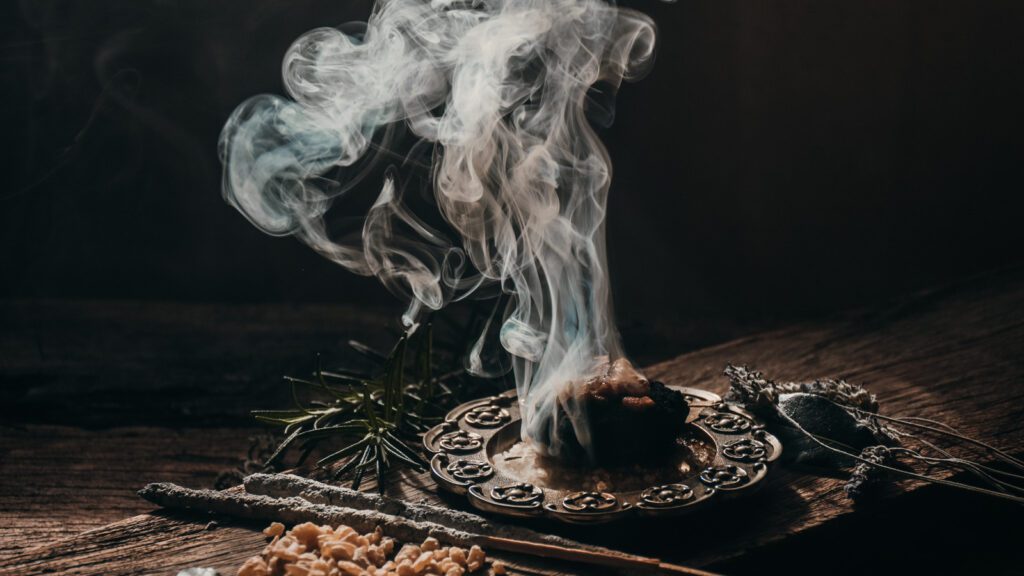
Stink the Place Up
Smell is the sense that is often overlooked in a lot of DM descriptions but it can have a huge impact. Smells can trigger a lot of feelings in a person and stick with them for a long time, recalling memories that can be either good or bad. You can make those memories a part of your game by adding the right fragrance to your scene. Here are a few things you can use to add a little aroma to your game area.
Incense
Incense comes in many forms and scents and is an easy way to transport someone’s senses to a different place. You can burn incense while your players are performing a magic ritual, during a service in a temple, or while they speak with some ancient soothsayer. Incense is generally pretty inexpensive and it doesn’t have to be burned for long for it to be effective. As a bonus, it also adds a nice smokey element to the ambiance in the room.
Candles
More difficult to use for lighting, candles are a great way to add some aroma to the air. You can get candles in just about any combination of scents you can imagine so it shouldn’t be too hard for you to find a scent to match your session. With the help of companies like Cantrip Candles, your job is made even easier with candles tailored to bringing your D&D sessions to life with scents like Black Hound Tavern, Dungeon Depths, and Brinewater Tides. Their candles can be purchased in 6 oz. tins or 16 oz. jars and are a great addition to your table.
Adventure Scents
Oddfish Games has come up with a unique product that they are calling scent special effects with their product Adventure Scents. Adventure Scents uses beads that are tossed in a highly fragranced oil to bring you a plethora of fragrances like Dragon’s Cave, Fetid Swamp, and Smokey Campfire to use at your roleplaying table. With 60 different scents to choose from you’re sure to be able to find one that makes sense to you. When stored probably these scents should last you up to two years!
Sending Smells Online
Unfortunately, I don’t have any good tips for this as technology has yet to master the concept of transferring smells over long distances. Just try to make sure that you include descriptions of smell in your games. Smell is just as important as your other senses!
Summary
- Ambiance is the environment around you and includes everything from sight, sound, touch, and smell.
- Focus on the senses when you are trying to describe the ambiance of a scene in your game.
- Background noise, soundtracks, and sound effects can help your players feel like they are in a different location, just don’t make it too distracting.
- Giving your players something they can physically hold keeps them paying attention to the game and feeling fully immersed in the story.
- Mood lighting can change the feeling of a room and can help set the tone for what your players are experiencing.
- Scents are often overlooked in descriptions and providing the proper scent for a fully immersive scene can leave a memorable impression on everyone at the table.
An elevated ambiance can turn a good game into a great one. By using the tools and tips I’ve mentioned you can level up your ambiance and give your players games they won’t soon forget. If there are any tools or tips you think I’ve left out, feel free to leave a comment letting me know. I’d love to hear what you’re using to make your games stand out!
